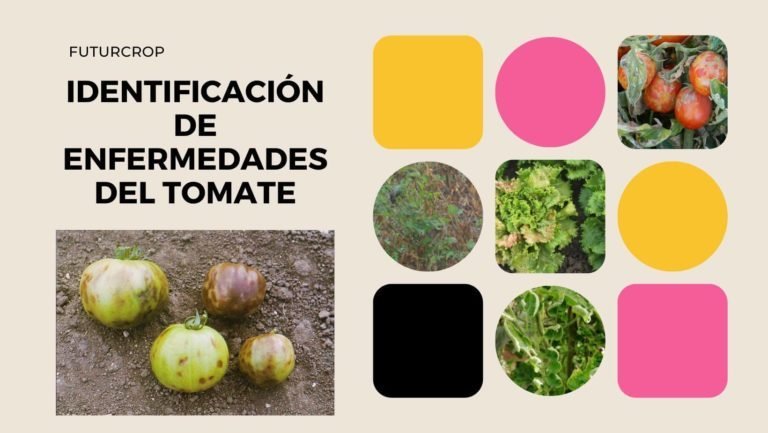
Guide for the Identification of Tomato Diseases
Symptoms of plant diseases It should be borne in mind that the symptoms of plant diseases are very dependent on the conditions of the infected plant: Control of plant diseases Control of viral plant diseases The two strategies that have the best impact on the control of viral plant diseases are the prevention of infection and the use of varieties resistant to the disease. In this regard, the following measures can be taken: Control of bacterial plant diseases In the same vein as viral diseases, preventive measures must be taken. Chemical control of non-viral diseases Viral diseases have no cure. The chemical control of other diseases, such as powdery mildew, is fundamentally based on the application of specific fungicidal products, systemic or sulfur-based. Viral diseases of tomatoes The most serious problems affecting tomato cultivation are caused by viruses, which are transmitted by insect vectors, mainly aphids, whiteflies and thrips. Sometimes the symptoms of viruses are very similar. For proper identification, especially in the face of abnormal symptoms, it is advisable to take samples for laboratory analysis. Among the main viral diseases of tomatoes are: Tomato Black Death or Tomato Tanning Virus (TSWV) It is transmitted through the action of thrips when feeding on plants, called insect vectors, especially Frankliniella occidentalis and to a lesser extent other species of thrips. . The vector acquires the virus in its immature stage and once acquired transmits the virus all its life. Once the plant is infected, symptoms begin to be visible 7 to 10 days later. Usually the whole plant manifests symptoms of the virus. The disease affects more than 550 species of plants, including important crops such as tomatoes, peppers, lettuce, etc. Tobacco Mosaic Virus (TMV) TMV mainly infects tobacco, but also other Solanaceae plants, such as tomatoes. The virus is transmitted very easily by contact, therefore through tools, or by the workers themselves. Like all viral diseases, the symptoms depend on the host plant. Symptoms of VMT can be mosaic, mottling, necrosis, stunting and rolling of the leaves and yellowing of plant tissues. Tomato yellow curl virus, or spoon virus (TYLCV) The TYLCV virus mainly affects tomatoes, but also green beans, chili, eggplant, etc. It can also infect ornamentals. It is transmitted through the whitefly (Bemisia tabaci) by feeding on infected plants. Symptoms appear between 10 and 20 days from the time the plant is infected. Tobacco ringspot virus (SVRT) The TRSV virus affects tomato, soy, eggplant, tobacco, cucumber, lettuce, etc. It is transmitted by ectoparasitic nematodes, specifically Xiphinema americana. In some host plants it is also transmitted by feeding insects, such as grasshoppers and thrips, as a result of their feeding. Cucumber mosaic (CMV) It affects numerous crops such as celery, pepper, tomato and other vegetables. It also affects weeds and flowers. The symptoms of CMV are very similar to those of Tobacco Mosaic Virus. The infection spreads through its insect vectors, in this case aphids. Bacterial diseases of tomato Fungal diseases can cause significant losses in crop yield and quality, reducing the useful life of plants and limiting their production and marketing (for example, due to fruit malformations), causing large economic losses. There are many diseases that can affect tomato cultivation: Leaf mold (Cladosporium fulvum), Rot caused by Alternaria alternata, Gray spot (Stemphylium solani), Smallpox (Septoria lycopersici), Bacterial freckle (Pseudomonas syringae), Bacterial spot (Xanthomonas campestris), Root or neck rot and wilting, wet stem rot caused by Sclerotinia spp., Neck and root rot (as a result of Phytophtora parasitica), Fusarium solani, bacterial cancer (Clavibacter michiganensis), basal stem rot caused by Sclerotium rolfsii, etc. But the following diseases stand out for their frequency: Downy mildew or Late Blight (Phytophthora infestans) This disease attacks the aerial part of the plant, at any stage of development, in conditions of high relative humidity (greater than 90%) and temperatures between 10ºC and 25º C. Powdery mildew (Leveillula taurica) It is characterized by the presence of a mold, a whitish dust present mainly in the green organs of the plant (leaves, stems and fruits), which reduces the photosynthesis capacity of the plant. It affects more than 1000 species of crops and weeds. Regarding crops, it mainly infects Solanaceae, such as tomae, pepper and eggplant Alternariosis or early blight (Alternaria solani) Warm temperatures of 24-29 ° C and high humidity favor the development of Alternariosis, which can occur at any time of the tomato growth cycle. The pathogen can hibernate in soil and plant residues. It spreads by contact, with splashes of water from the ground, running water, wind, work tools and machinery. It is manifested by the rotting of the fruits, although it can also affect the leaves, stem and petioles of the plant. Gray rot or mold (Botrytis cinerea) Botrytis is a parasitic fungus that mainly affects flowers and fruits, but also develops in stems, shoots and seeds. It is a necrophagous fungus, which affects more than 200 plants, mainly strawberries and fruits More than temperature, it depends on high relative humidity. To develop requires mild temperatures of 15 to 25ºC and high humidity. The frequency of rain, that the surface of the plant remains wet for too long, favor the appearance of Botrytis in plants A Botrytis infection will not become visible, as a rule, until two or three weeks after it began. If the infection can be observed with the naked eye, it means that the mold will have already penetrated the plant and it will not make sense to use a Botrytis is involved in what in winemaking is called “noble rot” which happens when more water evaporates from the infected grape due to the porosity of the infected ripe grapes. In that case, the wine will have a higher sugar content and more bouquet will not always cause damage. Cladosporiosis (Fulvia fulva) It affects many tomato crops more or less severely. It needs humidity conditions above 70% and temperatures between 5 and 25º C. Fusarium oxysporu It is the fungus that caused Panama Disease that caused serious losses in bananas

